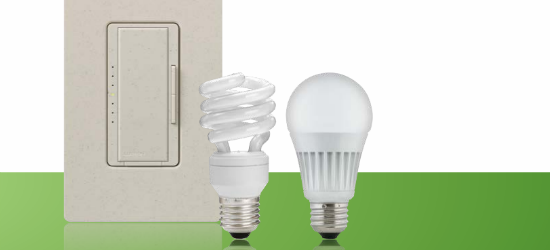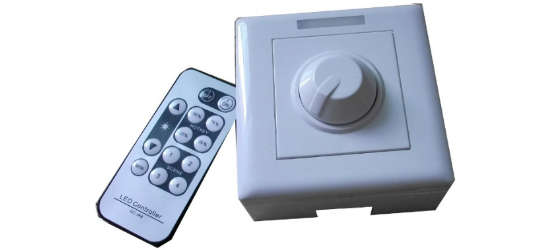Getting the Best LED Dimming Results

LED lights are becoming more and more popular in conventional lighting applications, such as in people’s homes and businesses. Some experts predict that by 2020 the LED market will be a $94 billion industry and account for 60% of the total lighting market.
What’s causing this huge boost of interest in LEDs? Well, there are several factors. First of all, by now the Energy Independence and Security Act of 2007 is totally in effect. This means many types of incandescent bulbs are no longer being manufactured, since they don’t meet the government’s new energy efficiency standards. Naturally, this change in the market has caused consumers to seek out new types of bulbs.
For many folks, LEDs are filling the void left by the phased out incandescents, since LEDs are known for their aesthetically pleasing light, durability, and of course, their energy efficiency. However, as with any type of transition, the switch to LEDs has had its hiccups. And one of the biggest areas where people are struggling is with dimmability. After all, the dimming capabilities of LEDs are one of the bulb’s biggest draws, as it gives users the same type of flexibility and control they enjoyed with incandescents.
The good news is LEDs are fully capable of complete, quality dimming when they are set up properly. Here’s what you need to know to make that possible…
How to Ensure Your LED Dims Properly
To have trouble-free dimming, you need to be aware of the following things:
1. Not all LEDs are dimmable.
You need to look carefully at the product’s packaging or specs to see if it is specifically labeled “dimmable.” Furthermore, not all LEDs dim to the same level or darkness.
2. Not all “dimmable” LEDs work with every type of dimmer.
Make sure the LED is compatible with the dimmer you are using. If you want to install the bulb to an existing incandescent dimmer, then you’ll need an LED that’s specifically labeled as being suitable for “incandescent dimmers.”
For better results, you may want to consider replacing your current switch and upgrading to a modern, specially designed LED dimmer. Many manufacturers suggest the best switch for their LEDs, which removes some of the guesswork when trying to choose the right combination.
3. Don’t take shortcuts.
Sometimes folks carelessly grab an LED off the shelf or pick one out of a catalog without really paying attention to whether or not it will work optimally with their setup. Unfortunately this can lead to difficulties and dissatisfaction with the product. Some of the common dimming issues people complain about are:
- Bulbs “dropping off” (i.e. turning off before the dimmer slider is completely down)
- Lights won’t turn on without readjusting the dimmer
- Lights flickering
Although common, these problems are totally avoidable if you use the right combination of dimmer, bulb, and driver.
Choosing the Right Products
To get the best LED dimming results, you have to pick coordinating products. However, because there are LED products for replacing virtually every type of lighting, things can get confusing. Here are some things to think about when making your decision:
1. How much dimming do you want?
The amount of dimness you want will likely vary depending on your application. For instance, when dimming something like a lobby, 20% minimum dimming might be acceptable. On the other hand, in a media room, you may need the light dimmed down to 0 or 1%. Define this expectation first, since it will narrow the number of drivers and controls to compare.
Also, it’s the driver that ultimately determines the possible dimming range while the control is responsible for delivering the performance of the dimming. You’ll have the greatest outcome by ensuring both these items are well-built and compatible.

2. Is the dimmer for a retrofit or new construction?
Some products are designed exclusively for new installation while others are specially designed to work with traditional fixtures. Concentrate your search on those suitable for your application and, above all, only choose LED coordinating drivers and switches.
3. How much load do you need for one dimmer?
Overloading and even underloading a dimmer can lead to poor performance. Thus, it’s important to install bulbs that meet the suggested load (volts, amps, or watts) for the dimmer. Keep in mind, LEDs draw more current on startup, so make sure the dimmer can handle the surge. Overlooking this can damage the dimmer or shorten its lifetime.
4. What type of control do you prefer or need?
There are a variety of dimming methods currently being used, and the type you select will vary depending on your personal preferences and the lighting setup you are working with. To give you an idea of what’s possible, here’s a brief explanation of the common dimming techniques used today:
- Forward phase control (aka “leading edge” or “triac”) This type of dimming is commonly used in retrofit situations, as it works with existing switches and drivers and doesn’t require the cost or labor of installing additional wiring. The tradeoff is you have less control over the level of dimming, and the controls experience a little more stress. Still, the power efficiency of the drivers is 80 – 85% (sometimes 90%), which can mean significant energy savings.
- Reverse phase control (aka “trailing edge”) This type of control is used in electronic low voltage dimmers (ELV) and works especially well with LEDs, since it doesn’t require any special stabilizing circuitry found in other LED-compatible dimmers. This eliminates flickering and other problems, as there is seamless communication with the driver. While reverse phase controls might deliver fantastic results, they are often four to five times more expensive than other options.
- DC dimming DC dimming offers a good balance of quality and cost-effectiveness, which makes it one of the most popular methods used today. Although it requires rewiring in retrofit applications, it can deliver complete “on/off” dimming and is extremely efficient. It’s important to note that in DC dimming, a 1-10V controller can work with a 0-10V driver, but a 0-10V controller is incompatible with a 1-10V driver. This confusion has caused 1-10V dimmers and drivers to mostly disappear from the market and for 0-10V products to become standard.
- Digital dimming Digital dimming is mostly used in theaters, auditoriums, and similar applications. It relies on a central control to dim multiple bulbs across many zones, and, because it can operate wirelessly through an iPhone, it is considered a “smart device.” Digital dimming requires creating a virtual network, which can lead to payments or dues to other services.
The Bottom Line
If we haven’t stressed it enough by now, the most vital thing to remember when installing LED dimmers is that the technology for all components must match. This means the controls, driver, and bulbs must be designed to work together. Again, manufacturers often recommend the ideal controls and drivers for bulbs, so it helps to do your research. Also, you can ask a lighting specialist such as Premier Lighting for advice, since they work with these parts every day and know what pairs well together.



i have nine chandlers in a 30×90 building and i would like to deem them all at the same time, each one has 300 watts, some have 600, is there a way to dim all at once or do i need to break them up?
john